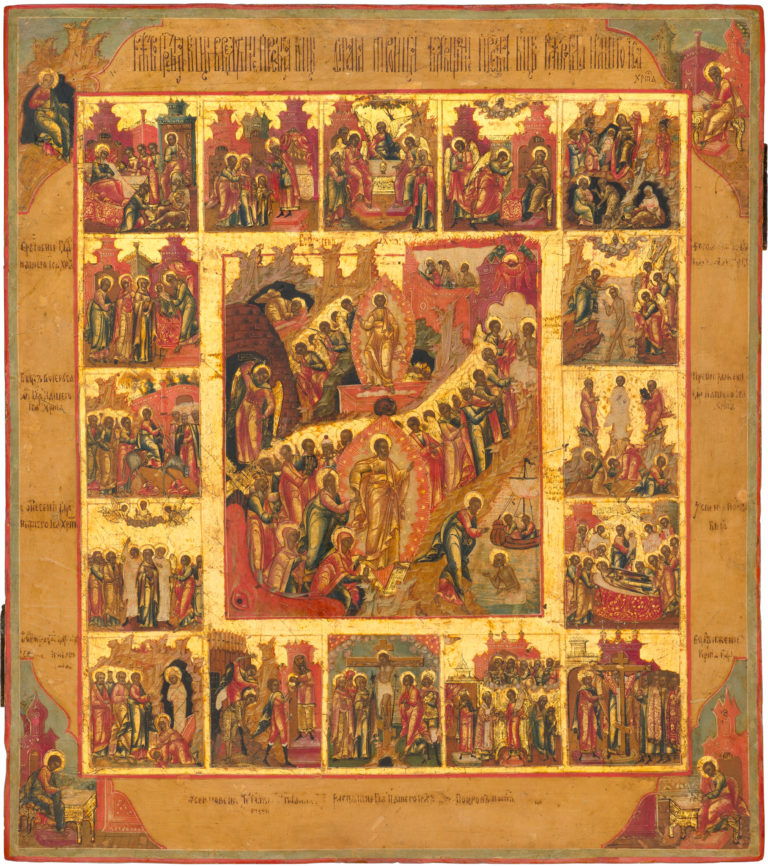The Resurrection—the Descent into Hell, with Church Feasts and the Four Evangelists in 16 Border Scenes
Antique Russian icon. First quarter of the 19th century. Palekh.
Size: 35 х 30.5 х 2 cm
Wood (one whole panel), two incut profiled support boards, absence of the incut centerpiece, underlying layer of canvas is not visible, gesso, tempera, gold.
The author’s paintwork is well preserved. Chafing and small fallouts of paint are minimal.
Contact us

The Resurrection—the Descent into Hell, with Church Feasts and the Four Evangelists in 16 Border Scenes
Diagram of the border scenes:
- The Nativity of the Mother of God;
- The Entrance of the Mother of God into the Temple;
- The Old Testament Trinity;
- The Annunciation;
- The Nativity of Christ;
- Candlemas (The Meeting of Christ in the Temple);
- The Theophany (The Baptism of Christ);
- The Entrance into Jerusalem;
- The Transfiguration;
- The Ascension;
- The Dormition of the Mother of God;
- The Raising of Lazarus;
- The Beheading of John the Baptist;
- The Crucifixion;
- The Pokrov (Feast of the Protective veil of the Mother of God);
- The Elevation of the Holy Cross;
- The Evangelist John the Theologian;
- The Evangelist Matthew;
- The Evangelist Mark;
- The Evangelist Luke.
The 19th century saw the rise in popularity of hand-painted Orthodox icons bearing the depiction of the Resurrection – the Harrowing of Hades surrounded by the main Feasts of the liturgical year. The iconographic scheme – with its many-figured centerpiece and a rich variation of border scenes – was especially popular among Palekh religious icon painters who led to its final development and, at the same time, preserved the traditions of the 17th-century Russian icon art.
The centerpiece of the given antique Russian icon bears a detailed variation of the Resurrection: on a single axis, we see the Rising from the Tomb and the Harrowing of Hades connected by a diagonal processional line of the Pious marching into Heaven. In the upper left part, we see the Saint Peter at the Empty Tomb; in the lower right – the Revelation of Christ to the Apostles on the Sea of Galilee. A noticeable trait of Palekh religious icon art is the depictions of the Gates of Hell in the upper left part of the centerpiece. They are depicted as a cone-shaped structure made of square masonry, at the door of which, we see an Angel binding Satan. Simplified versions of such depictions are found in a large number of later-period Palekh hand-painted icons, which is easily explainable, since artists relied on the same, circulating samples. The surrounding frame includes sixteen border scenes, the iconography and style of which are typical for the age. Following the Palekh tradition, the religious icon painter brings the Old Testament Trinity in the center of the topmost tier. In the lower tier, we see the Elevation of the Holy Cross, since the altar of Palekh’s main church was consecrated in honor of that Feast. The Crucifixion scene – placed in the center of the bottom tier – is a rare feature, probably included by the direct order of the commissioner. Another special trait of Palekh hand-painted icons is the depictions of the Four Evangelists in the corner segments, which resembles the highly decorated covers of Altar Gospels.
The given antique Russian icon is among the highly recognizable works of Palekh religious icon art brought to life in the first quarter of the 19th century and noted for their mastery. Among character traits of such Orthodox Church icons is “miniature” painting style with the highly detailed execution of the faces, the elegant proportions of the elongated figures, and the clarity of the composition. The iconographer managed to brilliantly bring detailed images into the tiny border scenes, placing numerous figures before complex, ornamented architectural motifs or colorful mountainsides covered with vines and grasses and veiled with feather-like blue-grey clouds. The resonance of the colors, the lavish amounts of gold covering the background of the border scenes and the centerpiece, the virtuoso ornamentation, and the rhythmic balance of the entire piece give this antique Russian icon a clear feeling of Paschal celebration.